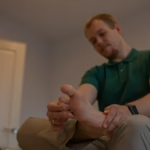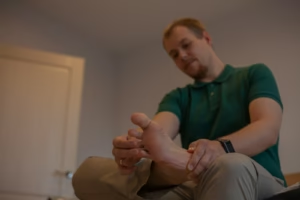Why Your Heel Hurts When Nothing Feels Broken
Did you know that almost 2 million people in the US end up seeing a doc for heel pain every year? However most end up wondering where on earth did that sudden stabbing heel pain come from with no clear reason or cause – no slip, trip, or anything to make it stand out from a typical day
If you’ve ever woken up to a sharp, jarring heel pain or just plain felt a shock of pain shoot through your foot while just going about your normal day, you’re far from alone.
This sort of inexplicable foot pain can be just plain annoying. It messes up your morning, limits your walking and leaves you wondering what the heck is going on?
The good news is though that most cases of sudden heel pain with no apparent reason are actually pretty easy to treat – if you know what to do
In this article we’re going to take a closer look at:
- What might actually cause that unexpected pain
- How to pick up on the warning signs as they pop up
- What steps you can take to start feel better
- Whether or not you should be looking into physio
Whether you’re trying to handle the pain on your own or considering seeing a pro, this guide will help you make some informed decisions when it comes to sorting out your foot.
Understanding Sudden Heel Pain Without Obvious Injury
Sudden heel pain that just shows up out of the blue is usually down to overuse, a change in your lifestyle or just how your body is put together – rather than something bad happening all at once.
Your heel is basically taking the brunt of your weight. When you walk, it’s like your heel is being hit with roughly 1.25 times your own body weight. That’s a lot to take on even with just day to day stuff going on.
The thing that usually causes trouble is plantar fasciitis.
This is what happens when the bit of tissue at the bottom of your foot (the plantar fascia) gets irritated or inflamed, even though it’s a pretty tough piece of muscle. But suddenly having heel pain can also be the result of other things like:
- your Achilles tendon getting worn out\
- bursitis (which is another kind of inflammation)\
- even minor changes in how your foot works
Take a look at how you live your daily life. Have you maybe started walking more? Maybe you swapped shoes for a new pair? Or you’ve found yourself on your feet more at work?
These gradual changes can trigger heel pain out of the blue – even though your body doesn’t always give you plenty of warning before it starts to go wrong. Sometimes discomfort just suddenly pops up when your tissues reach a breaking point.
The main thing to remember is, your heel is trying to tell you something. It’s not actually damaged, it’s just been overworked and is asking for a bit of help.
Identifying Symptoms and When to Seek Professional Help
Sudden heel pain often arrives with a pretty clear warning sign.
For most people, sharp pain is the first thing to make itself known in the mornings. But it can also show up after you’ve been sitting for a while – the pain being pretty hard to ignore if you’re not moving about for a bit. Then, as time goes by, the pain may start to ease up a bit as you get moving around some more – only to return again after you’ve been on your feet for a while.
Common signs that your heel needs some TLC:
- That shooting heel pain that hits you when you put your weight on it\
- Stiffness in your foot that just wont go away when you wake up or sit for too long\
- Your heel or sole of your foot is super sensitive when you press on it\
- Pain actually gets worse the more you try to exert yourself – be that playing sports or just going for a walk to the shops\
- Swelling or redness popping up around the heel area\
- And that pain can even radiate all the way up the back of your leg and into your arch too
When do you need to call in the help of a physiotherapist?
If the pain doesn’t start to clear up in about two weeks, it’s probably a good idea to get some expert advice. And of course, if the pain is starting to affect what you can do in daily life – or just getting worse in general, despite giving it a go on your own at home. A physio can take a close look at how you walk and the mechanics of your foot. They can figure out what’s causing the problem and come up with a plan that’s tailored to your specific needs.
Don’t put off getting help till the pain is unbearable though – getting ahead of the problem can make all the difference to your recovery.
Treatment Options and Relief Strategies
Good news is most sudden heel pain responds to conservative management.
You don’t need expensive interventions. Smart self care combined with professional support gets lasting relief.
Here’s what works:
- Rest and activity modification – Stop high impact activities. Swap running for swimming or cycling to keep fit while your heel heals.
- Ice application – Ice your heel for 15-20 minutes several times a day. Reduces inflammation and eases pain.
- Stretching exercises – Gentle calf stretches and plantar fascia stretches increases flexibility and reduces tissue tension.
- Supportive footwear – Wear shoes with good arch support and heel cushioning. Avoid flat shoes or worn out sneakers that puts pressure on your heel.
- Night splints or heel cups – These devices keeps your heel stretched overnight and protects your heel during vulnerable times.
- Physiotherapy interventions – A physiotherapist may use manual therapy, targeted exercises, shockwave therapy or other evidence based techniques tailored to your needs.
Start with these today. Most people see improvement within 4-6 weeks with consistent effort.
But if pain persists or worsens, professional physiotherapy will give you targeted guidance and specialized techniques your body needs.
Expert Insights and Research
Research shows early intervention and active rehabilitation is the best for heel pain. A study in the Journal of Foot and Ankle Research found 90% of plantar fasciitis cases resolve within a year with conservative treatment — especially when combined with targeted physio exercises.
Clinical evidence supports a multimodal approach: rest, stretch, strengthen, lifestyle changes tackles heel pain from all angles. Physios use this evidence based foundation to tailor treatment to each individual.
So your sudden heel pain is manageable. With understanding, patience and the right strategies most people get back to pain free movement. The key is to act early rather than hope the pain goes away on its own.
Preventative Measures for Long-Term Foot Health
Once your heel is feeling better, prevention is key.
These are the practical steps to keep it that way.
Keep stretching. Spend 5 minutes a day on calf and plantar fascia stretches. Do this even after the pain goes away.
Gradually increase activity rather than making big jumps. Your feet like gradual changes.
Invest in good shoes. Replace shoes every 300-500 miles. Get shoes with arch support and cushioning that matches your foot type.
Strengthen your feet and calves. Simple exercises like calf raises, towel scrunches and foot intrinsic strengthening build resilience. A physio can teach you exercises tailored to your needs.
Manage your weight. Extra weight loads up your heels and increases the risk of injury. Stay active with low impact movement you enjoy.
And finally, listen to your body. If the heel discomfort starts coming back, address it straight away with rest, stretching or professional guidance – before it becomes a bigger issue.
Take the Next Step Toward Heel Pain Relief
Heel pain without injury is weird, but it’s your body telling you something needs attention. The good news? This type of pain responds really well to proper care.
Start with the self care we’ve talked about. Stretch gently. Ice regularly. Wear supportive shoes. Most importantly, be patient with your healing process. Recovery takes weeks, not days.
If pain persists or is affecting your quality of life, a physio can assess and treat you. They’ll figure out why your heel hurts and create a plan to get you back to pain free movement.
Your feet carry you through life. They deserve care and attention. Ready to find out how physio can help your heel pain? Book a consultation with a local physio – or learn more about foot and ankle pain management on Physio Whisper.
What’s your biggest challenge with heel pain right now?
References
- American Academy of Orthopaedic Surgeons (AAOS) – Heel Pain Information https://orthoinfo.aaos.org/en/diseases–conditions/heel-pain
- National Institute of Arthritis and Musculoskeletal and Skin Diseases (NIAMS) – Plantar Fasciitis Overview https://www.niams.nih.gov/
- Journal of Foot and Ankle Research – Evidence-Based Treatment for Plantar Fasciitis https://jfootankleres.biomedcentral.com/
- Mayo Clinic – Plantar Fasciitis: Causes, Symptoms, and Treatment https://www.mayoclinic.org/diseases-conditions/plantar-fasciitis/symptoms-causes/syc-20354846
- American Physical Therapy Association (APTA) – Finding a Physical Therapist https://www.choosept.com/














